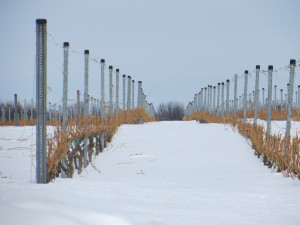Late Season Polar Vortex Pounds Ohio & Michigan
The report from Ohio State University yesterday regarding the Lake Erie grape growing region was not unexpected. This does not make the news any easier to swallow, however.
According to OSU, primary and secondary bud injury on vinifera vines was almost universal at the University’s two reporting stations. The Kingsville reporting station reached -14F on two occasions and the Wooster station was -12 on February 28th.
The end of February also brought the coldest temperatures of the winter to Traverse City, Michigan’s grape growing areas. On February 28th, the temperature in Traverse City dropped to an eerie -16F.
Why so cold two months after the winter solstice? The answer lies in the ice which now covers the “warm” water that normally protects the leeward shores of Lake Michigan and Erie. Now nearly iced over, the big Lakes are like taking a frozen hot water bottle to bed.
Midwest Wine Press was in Traverse City on February 28th for the Michigan Wine Conference. The mood was understandably more serious than other such gatherings in recent years.
“Anytime you get to -15F and -16F, you know there’s going to be extensive damage,” David Miller of White Pine Winery told a small gathering at a Michigan Conference session on winter damage assessment and prevention. (At the same time, a session on wine faults in another conference room attracted over 100 attendees, which demonstrates just how quickly news about this winter is getting old.)
With this year’s Great Lakes vinifera grape harvest in shambles, attention now turns to the spring. That’s when damage to the vines themselves will start to become apparent (or hopefully not.)
Speculating on the outcome of the “Massacre of 2014” is premature. However, someday we make look back at this winter as a watershed in the history of old world grape growing on the shores of the Great Lakes.
See: Ohio Grape Wine Electronic Newsletter
Note: Michigan and Ohio are not the only late winter cold spots. March 1st was the coldest March high temperature ever recorded (since 1888) in Kansas City with a high of 5F.



When I was in Traverse City a couple years ago I asked why no one grew any hybrids. I was told numerous times it doesn’t get cold enough to worry about it. I understand why they grow vinifera, but I asked then as I am now if it doesn’t make sense for them to differentiate to help aliviate the problem. Some colder hardy varieties in their mix would give them more stability looking forward. Just food for thought.
Irv,
Some Traverse City area wineries do have hybrids, but they don’t promote them. It will be interesting to see if more hybrids are planted as “insurance.” With its established wine industry, Northern Michigan could do a lot to promote consumer acceptance of hybrids.